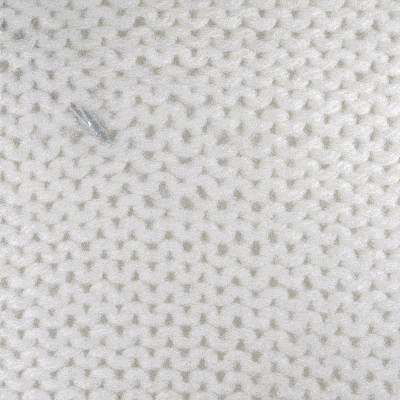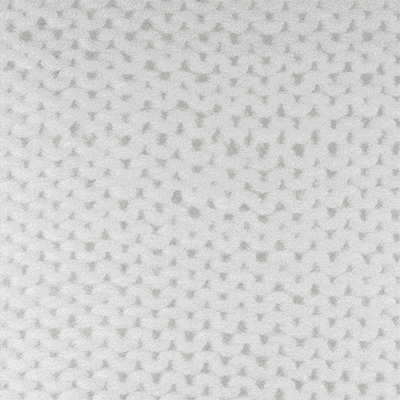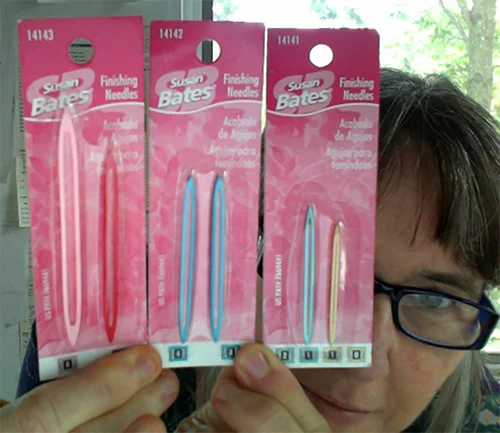Back in 2006, when I was knitting a particularly color-change-intensive baby blanket, I was worried I would run out of one of the colors of yarn, so I got very frugal and left all the "tails" of yarn only as long as would be needed to hold securely, once they were woven in. Common practice is to leave a longer tail than strictly needed, weave it in, and then cut off the remainder. But with all the color changes this would have, that wasted yarn would add up quickly.
Well, there were over 100 short tails when the blanket was done. And with every one, I encountered a problem all knitters sooner or later experience: when you're weaving-in and making the hairpin-turn that anchors a loose end, and it's a very short tail of yarn - like 2 cm/1 inch - the end will pop out of the eye of a regular tapestry needle when the needle is turned. At that point, to finish the job, it's necessary to insert the needle halfway, until the eye is close enough to the yarn stub, and re-thread it in situ.
Knitters generally prefer to waste yarn rather than do this.
So, about halfway through doing this with Every... Last ... Tail, an idea struck me for a tool that would make the job faster. It would allow the needle to keep the yarn in its eye when changing directions, even when only a quarter inch or so of yarn remained for the last weaving-in pass. It seemed like I had seen this sort of needle before, but I couldn't find one online, so I carved one out of a plastic jar lid. It made a huge difference!
Over the next couple of years I made more, at first using thick aluminum sculptor's armature wire, (the one in the image at the top of this page). But that's very soft aluminum; it bent too easily.
The best material that I was equipped to carve turned out to be lilac wood. I learned somewhere that lilac wood was used for crochet hooks and knitting needles in days of yore. I can see why: it has very fine grain, and almost the same carving texture across the grain as with it. It can take and keep a very smooth finish so it never snags. (But sadly no, it doesn't smell like lilac flowers.)
I continued to hunt for a needle designed like mine online with no success. I even scoured the archives of the US Patent and Trademark Office. To my surprise, it didn't exist anywhere. So I set about getting it patented. (It's a slow process.) Having done that, I sought a manufacturer I could license it to. Long story short, it is now made and sold by Susan Bates, the yarn-tool branch of the venerable Coats & Clarks. I am still hoping they will make some out of steel, which was my original goal. But I'm using the plastic ones now and they're great. I tend to use one a couple of sizes smaller than their yarn-weight designations, but I do that with knitting needles too. Your mileage may vary.
The first packaged ones Coats sent me.
One more thing, for the record: The finishing needle was NOT designed to be easier to thread than a regular tapestry needle. ("Whaaaaaaat???", I hear some of you thinking. Yes, that's what I said.) After all, if made in steel or wood, it wouldn't open wider -- without being structurally damaged, anyway. No, I figured anyone who can thread a regular tapestry needle can thread these, because finishing needle eyes aren't any narrower. (A much-used flexible finishing needle's eye will get narrower in the middle: the sides may even touch at the halfway point, but the ends of the eye will always have plenty of room for threading.) In case it helps, here's my all-purpose technique for threading needles:
How to easily thread any needle, showing worsted yarn being threaded into a Finishing Needle sized for fingering yarn, without widening the eye. Position the end of the yarn as shown. Practice rolling the thumb and index finger from tips-together to first-joints together. Note how it exposes the tip of the yarn. Then, with fingertips together again, hold the eye of the needle firmly against the tips of the fingers right over the yarn-end *while* exposing the yarn. The yarn has no where else to go but through the eye. (This video has no sound.)
The finishing needle exists to make short-tailed weaving-in easier & less time-consuming, so that millions of miles of good yarn don't get thrown away anymore. *shudder* To my fellow yarn lovers: I wish you smooth stitching and tidy skeins!


